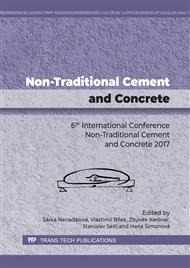p.35
p.39
p.45
p.49
p.57
p.61
p.65
p.69
p.73
Crack Initiation of Alkali-Activated Slag Based Composites with Graphite Filler
Abstract:
The alkali-activated slag is an alternative building material to ordinary Portland cement based materials. This type of material is effective in reducing CO2 emissions and energy consumption. Addition of graphite powder increases its electric conductivity, hence, introducing new functionality to building materials such as self-sensing and self-heating properties. In this study, the effect of graphite filler on the crack initiation of alkali-activated slag composite is investigated. The graphite powder was added in the amount of 5, 10 and 15% with respect to the slag mass. Beam specimens with an initial stress concentrator were tested in three-point bending at the age of 28 days. The load versus crack mouth crack opening displacement (F–CMOD) diagrams were recorded during the fracture tests and subsequently evaluated using the Double-K fracture model. This model allows the quantification of two different levels of crack propagation: initiation, which corresponds to the beginning of stable crack growth, and the level of unstable crack propagation. The course of fracture tests was also monitored by acoustic emission (AE) method.
Info:
Periodical:
Pages:
57-60
Citation:
Online since:
January 2018
Authors:
Price:
Сopyright:
© 2018 Trans Tech Publications Ltd. All Rights Reserved
Share:
Citation:


